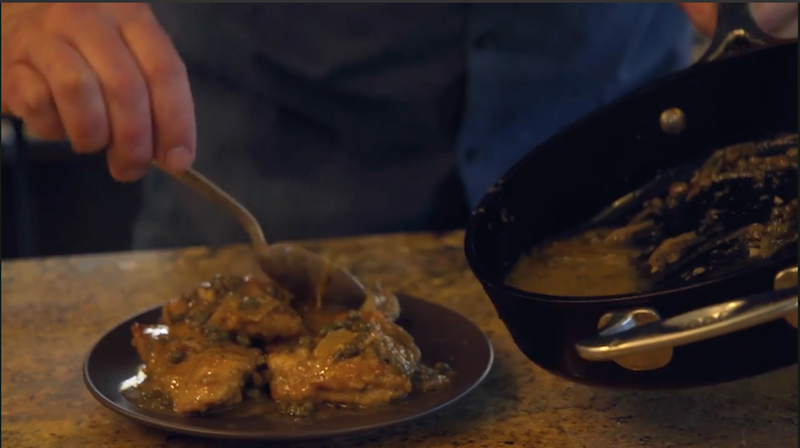Wild turkeys often get a bad rap by those who improperly prepare it.
Many claim it’s dry, tough and gamey. The bird you’re lucky enough to arrow isn’t the same as the Butterballs bagged at grocery stores. Wild birds are more active. They walk, run and fly to forage, mate and evade predators. Plus, they aren’t genetically engineered for large breast lobes. Naturally, wild birds are leaner, more muscular and, yes, tougher table fare, so you must prepare and cook them differently.
Hunting and eating wild birds still has advantages. You know where your meat comes from. Wild turkeys eat acorns, grains, seeds and insects. In contrast, farm-raised birds are fed mixed grains, oilseeds, and sometimes meat and bone meal. They’re also fed antibiotics.
Genetically engineered domestic turkeys have such large breasts that they can’t reproduce. Toms can weigh a whopping 70 pounds! Some are even sold as “flavor-enhanced.” That means they were injected with a saltwater solution to increase their weight, which also increases their cost without adding meat. Those injections add lots of unnecessary sodium, but moisten the meat and reduce the possibilities of overcooking.
Wild birds carry less fat and cholesterol than farm-raised turkeys. Consider this nutritional breakdown of a 3.5-ounce serving of wild turkey vs. a farm-raised broad-breasted white turkey.
TYPE: WILD TURKEY BROAD-BREASTED WHITE
Protein 25.7 grams 23.5 grams
Fat 1.1 grams 1.5 grams
Cholesterol 55 mg 60 mg
Calories 163 146
With any wild game, the steps you take between field and table can improve the taste. Remove the entrails and cool the meat as soon as practical. Field dressing is especially important if your arrow pierced the stomach or intestines. Flushing the carcass in a stream washes out blood and entrails, and quickly cools the bird. Get it on ice or in the refrigerator as soon as possible.
Not all turkey parts are created equal. The breast is juicier and much harder to ruin during cooking. In contrast, the sinewy legs should be treated differently. You can prepare the breast and thighs several ways with good results by grilling, frying or roasting, but slow-roasting the legs until the meat falls off the bone makes them much more palatable.

Have a Thanksgiving quality turkey year-round. Photo Credit: Cabela’s
Roasting is the classic way to cook turkeys. To keep your Thanksgiving dinner memorable for all the right reasons, baste the bird often with butter or wrap it with bacon. (Hey, everything is better with bacon!) Stuff the cavity with something moist, such as onions, apples and lemons. Roasting turkeys in oven bags also locks in moisture.
Turkeys can be cooked many delicious ways. Consider these recipes that feature several cooking methods – and flavors.
If your hunting skills far exceed your cooking skills, deep-frying a turkey is a great way to lock in moisture for a flavorful bird. Try this simple Cabela’s recipe.

Smoke your turkey for a delicious addition to the dinner table. Photo Credit: NWTF
The National Wild Turkey Federation has done much to restore turkeys to their native range. The organization continues to enhance wildlife habitat, protect our hunting heritage, and introduce newcomers to the sport.
The NWTF website is also a great resource for turkey hunters, whether you’re seeking hunting tips, entering your gobbler into the record book, or seeking new recipes. Smoked turkey is a delicacy. Consider the NWTF’s recipe for smoking wild turkeys.

This recipe is easy and uses the turkey breast. Photo Credit: TheMeatEater
Steven Rinella presents hunters and anglers in a new, realistic light to hunters and nonhunters with his Netflix Original series “MeatEater.” Rinella’s show focuses on hunting’s culinary aspects, with a tip of the cap to the excitement, camaraderie and beauty that make up the chase.
Watching “MeatEater”makes even poor cooks think, “I could do that!” Recipes on the “MeatEater”website, as well as Rinella’s best-selling cookbooks, make it seem easy. This Wild Turkey Piccata recipe is an easy, delicious way to prepare wild turkey breasts.

For lunch or dinner, this soup will put that turkey to good use. Photo Credit: CanCooker
Jacob Edson is communications manager for the Vista Outdoor Group, which does marketing and public relations for a host of companies. Edson is an avid hunter and no slouch in the kitchen. His recipe, Wild Turkey Leg Wild Rice Soup, is the definitive answer for those wondering what to do with turkey legs.
The day before you make the soup, place one turkey leg and thigh in a pot of clean water with a pinch of salt, one bay leaf, 1 cup of carrots and two celery ribs. Simmer covered for several hours until the meat falls off the bones yielding:
5 cups of turkey stock (strained) and 2 cups of shredded wild turkey.
Discard the rest.
Ingredients:
Directions: